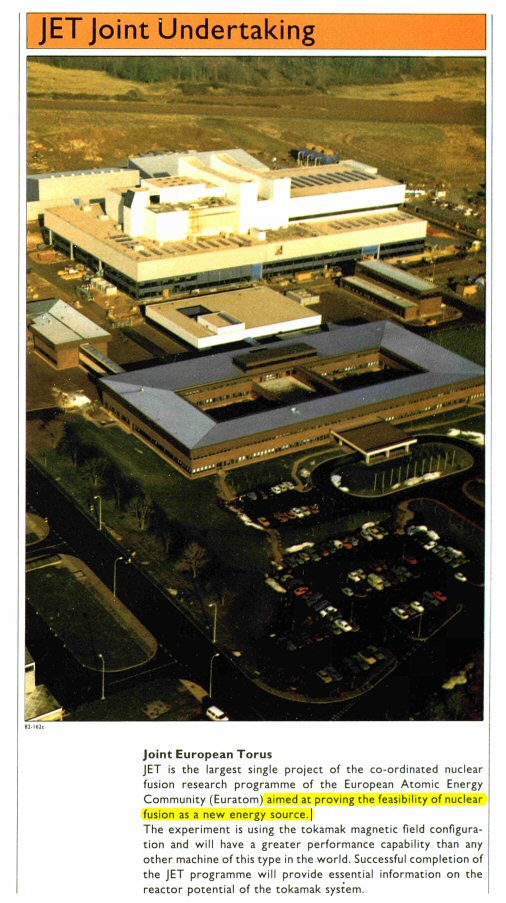#78 Uncovering the 700 MW Input Power Needed for the Joint European Torus Reactor

Cover image from 1988 EURATOM Report on the Joint European Torus Reactor
Return to ITER Power Facts Main Page
By Steven B. Krivit
Oct. 5, 2021
Most people I speak with who are first learning about the power discrepancies with fusion reactors are initially incredulous. They cannot believe that the Joint European Torus (JET) fusion reactor actually needed 700 megawatts of electricity to operate instead of 24 megawatts. They cannot believe that the International Thermonuclear Experimental Reactor (ITER) will require at least 300 megawatts of electricity to operate instead of just 50 megawatts.
They cannot believe that the planned SPARC reactor from the Massachusetts Institute of Technology/Commonwealth Fusion Systems partnership is not designed to produce net energy.
Some journalists — and television’s favorite physicist Michio Kaku — were even tricked into thinking that the National Ignition Facility produced fusion reactions that released 70 percent of the energy consumed by the device.
One of the most frequent questions people ask me is how I uncovered this trail of deception. It was an accident. I stumbled on it. Here is an excerpt from my 2016 book Fusion Fiasco, which explains the story.
——————
Thermonuclear Fusion 50 Years Later
Since the 1970s, thermonuclear fusion researchers and advocates had been saying that practical fusion reactors were just two decades away.
Ethan Siegel, a professor of physics and astronomy at Lewis & Clark College, who has a Ph.D. in astrophysics, wrote about the progress of fusion on the Forbes.com blog on Aug. 27, 2015: “The reality is we’ve moved ever closer to … the breakeven [power] point in nuclear fusion — where we get out as much [power] as we put in.” Yet there is still no practical fusion reactor, and no experimental reactor has produced a single watt in excess of the total power required to operate the reactor.
As I was checking basic facts about the claimed steady technical progress in fusion research — which I had assumed were correct — I discovered an astonishing discrepancy between what was publicly reported and the actual progress in net power produced by fusion.
Net-Power Representation
One of my technical editors [Mat Nieuwenhoven] asked whether I had information about the progress that had been made in increasing the net fusion power over the decades.
I sent an e-mail to Stephen O. Dean, the director of Fusion Power Associates, a nonprofit research and educational foundation, and asked whether he had such information. He didn’t. Slowly, the picture came into focus. I soon learned how important the insiders’ phrase “power injected” or “heating power” or “applied fusion power” was.
“The applied fusion power,” Dean wrote, “is not a relevant measure of progress since these have all been experiments not designed for net [power]. The input referred to is just the input to the plasma and does not include the power to operate the equipment.”
I was confused. I thought that the numbers — for example, the 65 percent cited for JET — reflected total net power. I asked him whether he knew the best total net power for those devices. He didn’t. I asked him whether this meant that JET’s and TFTR’s peaks were based on the input heating power rather than the total input electrical power. Yes, it did, he wrote. Now I was concerned.
As I soon learned, in addition to the power required to heat the plasma, power is consumed in tokamaks by a variety of processes. The greatest among these is the power required to create and maintain the magnetic field that suspends the plasma within the toroidal chamber.
Two Methods of Accounting
At first, I didn’t believe that fusion researchers normally accounted for only a fraction of the total input power when they stated net power values. I called [Michel Shaffer] a plasma fusion physicist who worked for General Atomics and asked him to explain this. He corroborated what Dean had told me. It was true.
Yes, people in the magnetic fusion research industry, since the 1970s, have always used applied heating power rather than total system input power when reporting their progress. I asked [Shaffer] whether he knew how much greater the actual total system input power was than the heating input power. He guessed that, typically, total input power was about 10 times as much. If this was correct, then fusion results had been exaggerated by an order of magnitude for decades.
I sent an inquiry to Nick Holloway, the media manager for the Communications Group of the Culham Centre for Fusion Energy, which operates the Joint European Torus. I told him that I understood JET had generated 16 MW fusion power with 24 MW applied heating power input. I asked him whether he could tell me about how much total input electrical power was required to make that much power.
“We don’t have the electrical power input figure for this pulse to hand unfortunately,” Holloway wrote. “Below is some information from my colleague Chris D. Warrick on JET’s typical electrical power levels, so it will be of this order. But if you do need the exact input figure we can find out.” Here is Warrick’s e-mail:
The general answer is that a JET pulse typically requires ~700 MW of electrical power to run. The vast majority of this goes into feeding the copper magnetic coils and the rest into subsystems and energizing the heating systems. In future machines, the copper coils will be replaced with superconducting coils – which will ensure the total input power is dramatically reduced. I don’t have on hand the specific numbers for this particular pulse.
Order of Magnitude Difference
Holloway and Warrick had confirmed it: The total input power was an order of magnitude larger than applied heating power, as was the value which has been universally used to represent the state of the art in thermonuclear fusion research.
The total system input power used for JET’s world-record fusion experiment was about 700 MW. Thus, a more accurate summary of the most successful thermonuclear fusion experiment is this:
With a total input power of ~700 MW, JET produced 16 MW of fusion power, resulting in a net consumption of ~684 MW of power, for a duration of 100 milliseconds. In other words, the JET tokamak consumed ~98% of the total power given to it. The “fusion power” it produced, in heat, was ~2% of the total power input.
As most of the public would understand the term “fusion power,” JET produced none. (This calculation assumes, for the sake of example, that the number of ~700 MW is a precise value to three significant digits, which it most likely is not.)
The truth about the overall efficiency of the reactors has been so well-hidden that even Charles Seife, the author of a pessimistic book on fusion, missed it. He, too, was unaware that the researchers were reporting their power input based on applied thermal power input rather than the total electrical power input. Seife thought that the best JET experiment had lost between 10% and 40% of the input power.
JET got 6 watts out for every 10 it put in. It was a record, and a remarkable achievement, but a net loss of 40 percent of [power] is not the hallmark of a great power plant. Scientists would claim — after twiddling with the definition of the [power] put into the system — that the loss was as little as 10%. This might be so, but it still wasn’t breakeven; JET was losing energy, not making it.
Seife had no idea that JET actually lost about 98% of the input [power], rather than 10% to 40% of the input [power]. The shorthand typically used to describe energy production in the fusion community has created a mistaken view of its success among most observers.
——————
Insight Into ITER
That’s the end of the excerpt from my book.
I had already consulted with Google. But at the time Holloway sent me the 700 MW value, on Dec. 1, 2014, I had been unable to find any book or Web page that cited a value for the overall JET input power requirement. Only after learning the input value from Holloway was I able to put that number into my search criteria and locate a published reference for it.
A copy of the e-mail I had received from Holloway is on this Web page, as are all the sources that I have located for the input power requirements for ITER.
Once I understood how fusion scientists had almost universally communicated the results of JET, I realized that they had done the same thing with the projected power values for ITER. And I later saw the Massachusetts Institute of Technology/Commonwealth Fusion Systems scientists doing it, too.
Coming back to Nieuwenhoven’s question about the progress in power output from reactors over the decades, I have produced a detailed report called “When Will We Get Energy From Nuclear Fusion?” that addresses this question.

Image and text from EURATOM Report 1988

Text from ITER organization Web site, Oct. 5, 2021

